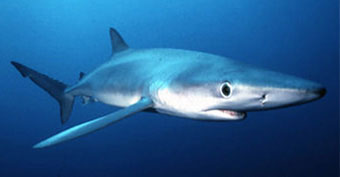Scientist utilizes Giovanni to map baby blue shark nursery
January 12, 2010

A study to be published in the 15 January 2010 issue of Fisheries Research describes characterization of an oceanic region in the southwest Atlantic Ocean, near the coast of southern Brazil, where juvenile blue sharks (Prionace glauca) are found in high numbers. One of the unusual aspects of the region is that mature blues are not found in the region.
The research paper authored by Santiago Montealegre-Quijano and Carolus M. Vooren of the Universidade Federal do Rio Grande (FURG) Instituto de Oceanografia, Laboratório de Elasmobrânquios e Aves Marinhas, utilized data from commercial fishing operations. The researchers determined that juvenile blue sharks stay in the region until they are about 1.3 meters in length. Then, the juvenile sharks disperse, with the young male sharks heading north, and the young female sharks heading south, south of the Subtropical Convergence Zone, waiting to head north until late austral summer.
Sea surface temperatures from MODIS, analyzed with Giovanni, a data exploration analysis and visualization tool developed in part by a collaborative effort involving SESDA II scientists and engineers were used to characterize the location of the Subtropical Convergence Zone during the study period. These data helped to determine the location of the convergence zone during the periods when the fishing stations were observed. According to the authors, the Subtropical Convergence Zone occurred in the study area from late autumn into spring. The study describes possible migration routes of pregnant female blue sharks through the southwest Atlantic and how they return to the nursery zone to give birth to baby blue sharks.
Comments are closed.
-
Article Details:
Posted on: Tuesday, January 12th, 2010
Posted in: News
Subscribe: RSS 2.0
Comments: No Responses -
Recent News:
